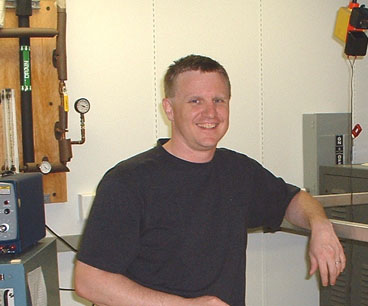 330-672-2246 (Chair's office); FAX: 2959
330-672-2246 (Chair's office); FAX: 2959 330-672-9592 (lab)
330-672-9592 (lab)
jgleeson

 330-672-2246 (Chair's office); FAX: 2959
330-672-2246 (Chair's office); FAX: 2959
 330-672-9592 (lab)
330-672-9592 (lab)

jgleeson
Out-of-equilibrium behavior might be defined as those phenomena observed when, by one way or another, energy flows through our complex fluid. When a pot is placed on a hot stove, the temperature gradient can spontaneously induce circular flow in the soup in the pot. In close analogy, when an electric current, caused by a gradient in the electric potential, is passed through a liquid crystal, under appropriate conditions the liquid will also spontaneously undergo organized, circular flow.
This flow, called electro-hydrodynamic convection, can be optically detected (see caption), and is an almost ideal model system for studying pattern formation. Pattern formation usually refers to the problem of how organized, complicated structures spontaneously arise in a completely uniform environment; the most famous example is how does a snowflake form in a cloud when there is no template up there to dictate its shape? We study pattern formation under tightly controlled experimental conditions, using liquid crystals with which the underlying symmetries of the uniform environment may be exquisitely controlled. Liquid crystals have been referred to as "Nature's Delicate State of Matter" precisely because they are far more sensitive to external influences than other states of matter; this makes them excellent candidates for studying the effect of external influences on pattern formation.
Another important problem in complex fluids is how does an externally imposed (rather than spontaneous) flow affect the fluid's bulk properties? Any material reacts to an external perturbation sooner or later. Unfortunately, most simple liquids react so quickly to imposed flow that it is not possible to make the flow rapid enough to significantly alter the state of the liquid. Many "exotic" fluids, like polymer solutions, polymer melts or suspensions of detergent-like molecules in water react so much more slowly that one can induce enormous changes in the microscopic and/or macroscopic state of these fluids simply by forcing them to flow, for instance by placing the fluid between a stationary and a moving plate. In Dr. Gleeson's laboratory there is a state-of-the-art, custom built apparatus for the optical study of fluids during flow. With this apparatus, our group hunts for the spontaneous formation of stripes in liquid crystalline polymers, flow induced transitions between topologically distinct phases in detergent-water emulsions, and growth of ordered domains of micro-phase segregated diblock copolymer melts when subject to oscillatory flow.
Since many of our experimental programs are centered around optical images, Dr. Gleeson's laboratory contains a variety of general purpose and specialty microscopes, all of which are interfaced to microcomputers equipped with high resolution image processing capability. Students who work in this environment necessarily become familiar with an diverse array of valuable skills, such as mechanical and electronic design and fabrication, sophisticated materials handling, techniques of optical measurement, and computer programming for image analysis.